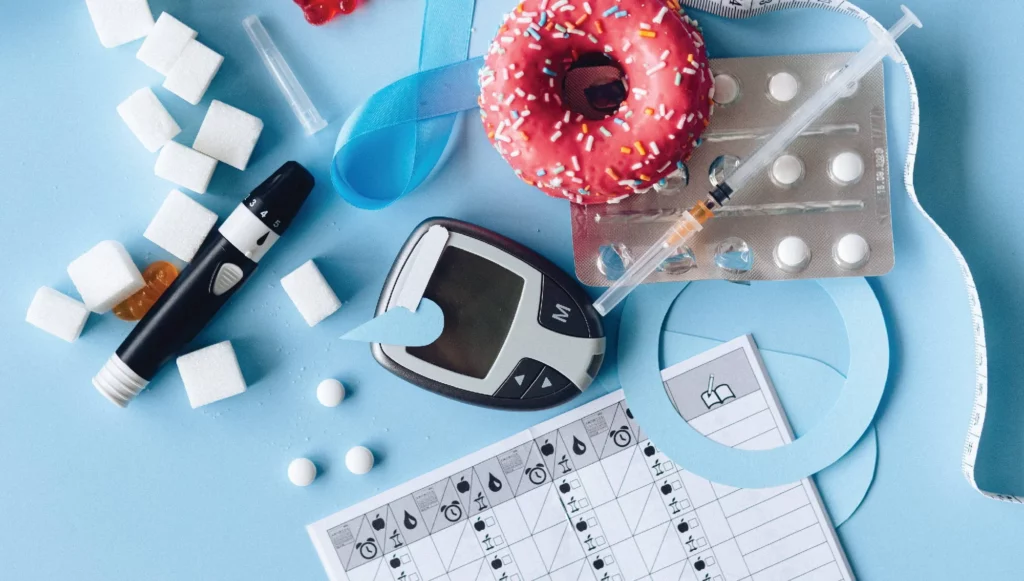Managing blood sugar levels is crucial for individuals with diabetes. While lifestyle modifications like diet and exercise play a significant role, many people also require medication to control their blood glucose levels effectively. One class of medications commonly used for this purpose is known as glycemic medication. In this blog, we’ll delve into what glycemic medication is, how it works, the different types available, and considerations for their use.
Contents
What is Glycemic Medication?

Glycemic medication, also known as antihyperglycemic medication or diabetes medication, refers to drugs specifically designed to help regulate blood sugar levels in individuals with diabetes. These medications are used to manage both type 1 and type 2 diabetes by assisting the body in maintaining healthy blood glucose levels. Glycemic medications work through various mechanisms, including increasing insulin production, improving insulin sensitivity, reducing glucose production in the liver, and enhancing glucose uptake by cells.
The primary goal of using glycemic medication is to achieve glycemic control, which involves keeping blood sugar levels within a target range to prevent complications associated with diabetes, such as cardiovascular disease, neuropathy, kidney damage, and vision problems. Glycemic medication is often prescribed alongside lifestyle modifications, such as diet and exercise, to optimize diabetes management.
Types of Glycemic Medication
Glycemic medication encompasses various classes of drugs used to manage blood sugar levels in individuals with diabetes. These medications work through different mechanisms to achieve glycemic control, which involves keeping blood glucose levels within a target range. Here are the main types of glycemic medication:
Insulin
Insulin is a hormone produced by the pancreas that regulates blood sugar levels by facilitating the uptake of glucose into cells.
Types of insulin include:
- Rapid-acting insulin: Begins working within minutes and peaks within 30 minutes to 3 hours.
- Short-acting insulin: Starts working within 30 minutes to an hour and peaks in 2 to 4 hours.
- Intermediate-acting insulin: Begins working within 1 to 2 hours and peaks in 4 to 12 hours.
- Long-acting insulin: Takes several hours to start working and provides a steady level of insulin over a longer period, usually up to 24 hours.
Insulin therapy may involve multiple daily injections or the use of insulin pumps.
Oral Medications

Oral medications are primarily used for managing type 2 diabetes, although some may also be used in combination with insulin for type 1 diabetes.
Common classes of oral medications include:
- Biguanides: e.g., Metformin. These medications reduce glucose production in the liver and improve insulin sensitivity.
- Sulfonylureas: e.g., Glipizide, Glyburide. These drugs stimulate insulin secretion from the pancreas.
- DPP-4 Inhibitors (Dipeptidyl Peptidase-4 Inhibitors): e.g., Sitagliptin, Saxagliptin. They increase insulin secretion and decrease glucagon production.
- SGLT2 Inhibitors (Sodium-Glucose Cotransporter-2 Inhibitors): e.g., Canagliflozin, Empagliflozin. These drugs reduce blood sugar levels by increasing glucose excretion in the urine.
- Thiazolidinediones: e.g., Pioglitazone, Rosiglitazone. These medications improve insulin sensitivity in peripheral tissues.
Injectable Medications
Injectable medications are typically used for managing type 2 diabetes.
Common types of injectable medications include:
- GLP-1 Receptor Agonists (Glucagon-Like Peptide-1 Receptor Agonists): e.g., Liraglutide, Dulaglutide. These drugs stimulate insulin secretion, inhibit glucagon secretion, and slow gastric emptying.
- Amylin Analogues: e.g., Pramlintide. They help regulate blood sugar levels by slowing gastric emptying and suppressing glucagon secretion.
Each type of glycemic medication has its mechanism of action, onset of action, duration of action, and potential side effects. The choice of medication depends on factors. These are such as the type of diabetes, individual health status, other medical conditions, medication cost, and patient preferences.
How Glycemic Medication Works?

Glycemic medication works through various mechanisms to help manage blood sugar levels in individuals with diabetes. These medications are designed to address the underlying abnormalities in insulin production, insulin sensitivity, and glucose metabolism that characterize diabetes. Here’s how glycemic medication works:
Increasing Insulin Production:
- Some medications stimulate the pancreas to produce more insulin. Insulin is a hormone that helps regulate blood sugar levels by facilitating the uptake of glucose into cells.
- Drugs like sulfonylureas and meglitinides work by binding to specific receptors on the pancreas’s beta cells, which triggers insulin release into the bloodstream.
Improving Insulin Sensitivity:
- Other medications work by improving the body’s sensitivity to insulin. In individuals with insulin resistance (common in type 2 diabetes), cells have difficulty responding to insulin, leading to elevated blood sugar levels.
- Drugs like biguanides (e.g., Metformin) enhance insulin sensitivity in peripheral tissues, such as muscle and fat cells, allowing them to more effectively absorb glucose from the bloodstream.
Decreasing Glucose Production:
- Certain medications reduce the production of glucose in the liver. The liver plays a crucial role in maintaining blood sugar levels by releasing glucose into the bloodstream when needed.
- Biguanides like Metformin primarily work by suppressing glucose production in the liver, thereby lowering fasting blood sugar levels.
Enhancing Glucose Excretion:
- Some drugs promote the excretion of glucose in the urine, leading to a reduction in blood sugar levels.
- Sodium-glucose cotransporter-2 (SGLT2) inhibitors, such as Canagliflozin and Empagliflozin, work by inhibiting the reabsorption of glucose in the kidneys, causing excess glucose to be excreted in the urine.
Stimulating Insulin Secretion and Inhibiting Glucagon Release:
- GLP-1 receptor agonists (e.g., Liraglutide, Dulaglutide) stimulate insulin secretion from the pancreas in response to elevated blood sugar levels. They also inhibit the release of glucagon, a hormone that raises blood sugar levels.
- DPP-4 inhibitors (e.g., Sitagliptin, Saxagliptin) work by blocking the enzyme dipeptidyl peptidase-4 (DPP-4), which degrades incretin hormones like GLP-1. By prolonging the action of incretins, these drugs enhance insulin secretion and inhibit glucagon release.
Slowing Gastric Emptying:
- Amylin analogs (e.g., Pramlintide) help regulate blood sugar levels by slowing the emptying of the stomach. It reduces the rate at which glucose enters the bloodstream after a meal.
Dosage and Administration of Glycemic Medication
When it comes to the dosage and administration of glycemic medication, it’s crucial to follow the recommendations provided by healthcare professionals closely. Here’s a general overview of how these medications are typically managed:
Dosage
- The dosage of glycemic medication is determined based on various factors. This includes the type and severity of diabetes, individual health status, age, weight, renal function, and response to treatment.
- Healthcare providers will prescribe an initial dose that is tailored to the individual’s needs. You may adjust it over time to achieve optimal blood sugar control while minimizing side effects.
- Dosages may vary depending on the specific medication, its formulation, and the frequency of administration. It’s essential to adhere to the prescribed dosage and not to exceed or skip doses without consulting a healthcare provider.
Administration
- The administration of glycemic medication varies depending on the type of medication and its formulation.
- Oral medications are typically taken by mouth with or without food, as directed by a healthcare provider. Some medications may need to be taken once daily, while others may require multiple doses throughout the day.
- Injectable medications are administered subcutaneously (under the skin) using prefilled pens or syringes. The injection site and technique may vary depending on the specific medication. It should be rotated to prevent tissue damage and ensure proper absorption.
- Insulin, in particular, requires careful administration, including proper handling of insulin vials or cartridges, selection of injection sites, and adjustment of injection technique based on individual preferences and comfort level.
- Combination therapy involving multiple medications may require coordination of dosing schedules and administration techniques to optimize treatment outcomes.
Monitoring and Adjustments
- Regular monitoring of blood sugar levels is essential to assess the effectiveness of glycemic medication and make any necessary adjustments to the treatment plan.
- Individuals with diabetes may be advised to monitor their blood sugar levels regularly using a glucometer, continuous glucose monitor (CGM), or other monitoring devices. The frequency of monitoring may vary depending on individual circumstances, treatment goals, and healthcare provider recommendations.
- Dosage adjustments may be made based on changes in blood sugar levels, diet, exercise, weight, medication adherence, and other factors. It’s essential to communicate any concerns or changes in symptoms to a healthcare provider promptly.
Potential Side Effects of Glycemic Medication
Glycemic medication, like any other medication, can have potential side effects. These side effects can vary depending on the type of medication, the dosage, and individual factors such as age, overall health, and the presence of other medical conditions. It’s essential to be aware of these potential side effects and to discuss them with a healthcare provider. Here are some common side effects associated with various classes of glycemic medication:
- Hypoglycemia (Low Blood Sugar): Many glycemic medications, particularly insulin and certain oral medications like sulfonylureas, can cause hypoglycemia, characterized by shakiness, dizziness, sweating, confusion, and rapid heartbeat. Hypoglycemia can be dangerous if left untreated and may require immediate consumption of glucose-containing foods or beverages to raise blood sugar levels.
- Gastrointestinal Symptoms: Some oral medications, such as metformin and thiazolidinediones, may cause gastrointestinal side effects such as nausea, vomiting, diarrhea, and abdominal discomfort. Furthermore, these side effects are usually temporary. It may improve over time as the body adjusts to the medication. Taking the medication with food or dividing the dose can sometimes help alleviate gastrointestinal symptoms.
- Weight Gain: Certain glycemic medications, such as sulfonylureas and thiazolidinediones, may be associated with weight gain in some individuals. Weight gain can be problematic, particularly for individuals with type 2 diabetes who are already at risk of obesity and related complications such as cardiovascular disease.
- Fluid Retention and Edema: Some medications, such as thiazolidinediones, may cause fluid retention and swelling (edema) in the legs, ankles, or feet. Fluid retention can exacerbate existing cardiovascular conditions and may require close monitoring by a healthcare provider.
- Increased Risk of Urinary Tract Infections and Genital Infections: Sodium-glucose cotransporter-2 (SGLT2) inhibitors, while effective in lowering blood sugar levels, may increase the risk of urinary tract infections and genital yeast infections in some individuals. Symptoms of urinary tract infections may include frequent urination, burning sensation during urination, and lower abdominal pain, while genital yeast infections may cause itching, redness, and discharge.
Considerations for Glycemic Medication Use

When considering the use of glycemic medication for managing diabetes, several important factors should be considered to ensure safe and effective treatment. Here are some key considerations:
- Type and Severity of Diabetes: The type of diabetes (type 1, type 2, gestational, etc.) and its severity will influence the choice of glycemic medication and treatment approach. For example, individuals with type 1 diabetes typically require insulin therapy, while those with type 2 diabetes may initially start with lifestyle modifications and oral medications before progressing to insulin or other injectable therapies if needed.
- Individual Health Status: Factors such as age, overall health, presence of comorbidities (e.g., cardiovascular disease, kidney disease), renal function, liver function, and any allergies or sensitivities should be considered when selecting glycemic medication. Certain medications may be contraindicated or require dosage adjustments in individuals with specific medical conditions.
- Medication Adherence: Medication adherence is critical for achieving optimal glycemic control and reducing the risk of complications associated with diabetes. Consideration should be given to the individual’s ability to adhere to the prescribed treatment regimen. This includes the frequency of dosing, administration techniques, and potential lifestyle adjustments.
- Side Effects and Tolerability: Each class of glycemic medication has its own set of potential side effects. It should be discussed with the individual before initiating treatment. Healthcare providers should assess the individual’s tolerance to medication and monitor for any adverse reactions or complications that may arise during treatment.
- Risk of Hypoglycemia: Certain medications, such as insulin and sulfonylureas, carry a risk of hypoglycemia (low blood sugar). Individuals at higher risk of hypoglycemia, such as older adults or those with erratic eating patterns, may require closer monitoring and adjustments to their medication regimen to minimize this risk.
- Renal Function: Many glycemic medications are excreted through the kidneys and may require dosage adjustments in individuals with impaired renal function. Regular monitoring of renal function, including serum creatinine and estimated glomerular filtration rate (eGFR), is essential to ensure safe medication use.
- Drug Interactions: Some glycemic medications may interact with other medications, supplements, or herbal products, potentially affecting their efficacy or increasing the risk of adverse effects. Healthcare providers should review the individual’s medication list and consider potential drug interactions when prescribing glycemic medication.
- Pregnancy and Lactation: Special considerations apply to the use of glycemic medication in pregnant or breastfeeding individuals. Certain medications may be safer or preferred during pregnancy, while others may need to be adjusted or discontinued. It’s essential to consult a healthcare provider for personalized guidance in these situations.
Conclusion
Glycemic medication plays a crucial role in the management of diabetes. It is by helping to regulate blood sugar levels and reduce the risk of complications associated with the condition. With various classes of medications available, treatment can be tailored to individual needs, providing patients with effective glycemic control and improving their overall quality of life. However, it’s essential to work closely with a healthcare provider. It is to determine the most suitable medication regimen and to monitor blood sugar levels regularly to ensure optimal outcomes.

